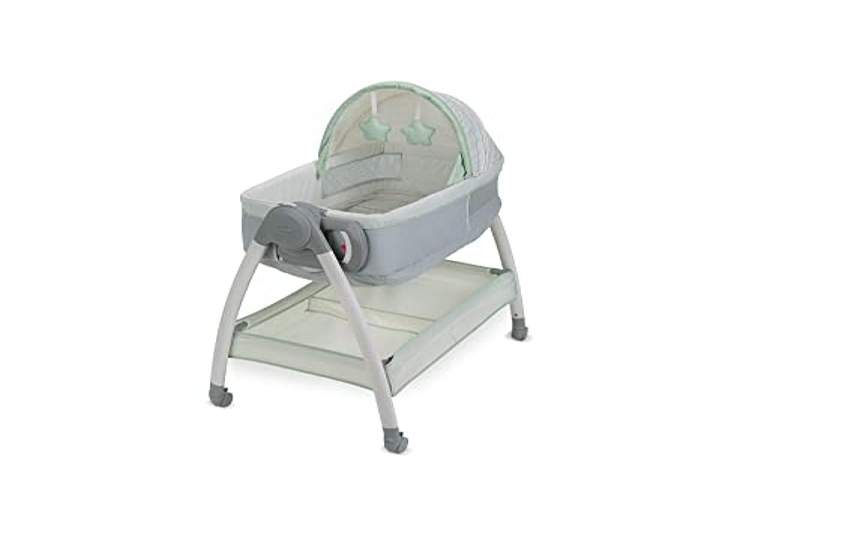Washing a bassinet canopy is not an easy task. It’s important to do it properly to avoid damaging the fabric and stitching on your new baby’s bed. Here are some steps that will help you on How to Wash Bassinet Canopy!

Steps on Washing a Bassinet Canopy
Step 1. Begin by removing the canopy from your bassinet – this can be done simply by unhooking it. If you are unable to do so, ask someone for assistance. You will want an extra set of hands available to help hold the fabric up as well!
Step 2. Place your canopy flat on a clean surface and begin spraying at one corner with water until fully soaked through the material – avoid using hot or boiling water as this may damage some fabrics.
Allow it to sit for several minutes then spray with cold water if desired to prevent soaking which could lead to discolouration/staining later down the line during reassembly.
Step 3. Always remember that how darkly coloured parts of your bassinet are, how light the material of your bassinet canopy is and how much water pressure you have in your hose will determine how long it takes for each part to soak through.
Step 4. Using a flat head screwdriver or another tool with a wide edge, begin working at one corner where the fabric meets metal by carefully prying up any clips that may be present until fully removed from the frame. Be careful not to rip wood if applicable as this could lead to irreparable damage!
Continue removing all corners of the metal x shaped support beams until the entire top can be lifted off and then set aside on a clean surface – do NOT attempt step two without first doing so!!!
Step 5. Next, take the post portion of the canopy using pliers and remove screws holding together. This may also be helpful to use a flat head screwdriver or another tool with a wide edge at the base of how some screws are attached to release them.
Step 6. Now that you have your top and bottom separate, place the bassinet canopy into the washing machine with cold water on a gentle cycle using a mild detergent such as Woolite (do not add any fabric softener).
Note:
A small amount of bleach may be added if needed but again this is too much risk for damage so should only be used when necessary!
Let it soak through thoroughly until all soap has been rinsed completely from cotton/fabric before placing back onto the drying rack – do NOT attempt step three without first doing so! Hang dry outside or over the shower curtain rod in the bathroom or laundry room.
How to Assemble Kolcraft Cuddle N Care Bassinet
Step 1. Place bassinet in the pre-assembled frame. Fasten top rail to the end of bottom rail and repeat for the opposite side. There should be no gap or space between the rails where a baby could get stuck but spaces around how much is needed so that it’s not too wobbly – you don’t want your child to tip over!
Step 2. Attach the mobile arm, turning the screw on one side until both sides attach at the same time (you may have to hold down another end). It doesn’t need to be super tight as any excessive force can damage the plastic parts inside making them brittle and breakable.
Just make sure they are snug enough that there is minimal wobble during normal use (ie; when the baby isn’t shaking it).
Step 3. Attach music box. The two halves of the toy arm will need to be pressed together and aligned with how much is needed so that it’s not too wobbly – you don’t want your child to tip over!
For older models where there are no grooves on each side, place one half into the other until they click together (you may have to hold down the other end) then twist clockwise until snug but still able to turn without excessive force.
Step 4. Again, just make sure they are snug enough for normal use. You can add a dab of super glue if in doubt about how tight something should be as this won’t damage plastic parts inside like regular glue would do but is slightly more permanent than toothpicks or tape which can be removed.
Washing a Bassinet: Important Steps
When cleaning a bassinet it’s important not to leave any soap or water on for more than a few hours as these may cause damage over time like rusting metal parts inside which could lead to injury for your child so always wipe down after use and inspect regularly before allowing baby back into bed just in case!
What Type of Plastic Is It Made Of?
There are many different types of plastics used outdoors but those most often found in bassinets include ABS (acrylonitrile-butadiene-styrene) or polycarbonate plastic. It’s important to remember that these two plastics are very different and how you clean each type will be determined by the first letter of their three initials.
ABS Plastic: This is one of the most popular types of plastic used in bassinets (and many other things like lego, binoculars, car parts etc.) but how it reacts to various cleaning agents can differ depending on its formula.
For example, ABS products made with Polybutylene Terephthalate (PBT), such as those produced by Britax–Römer®, quickly discolour when exposed to any water so this means no steaming!
